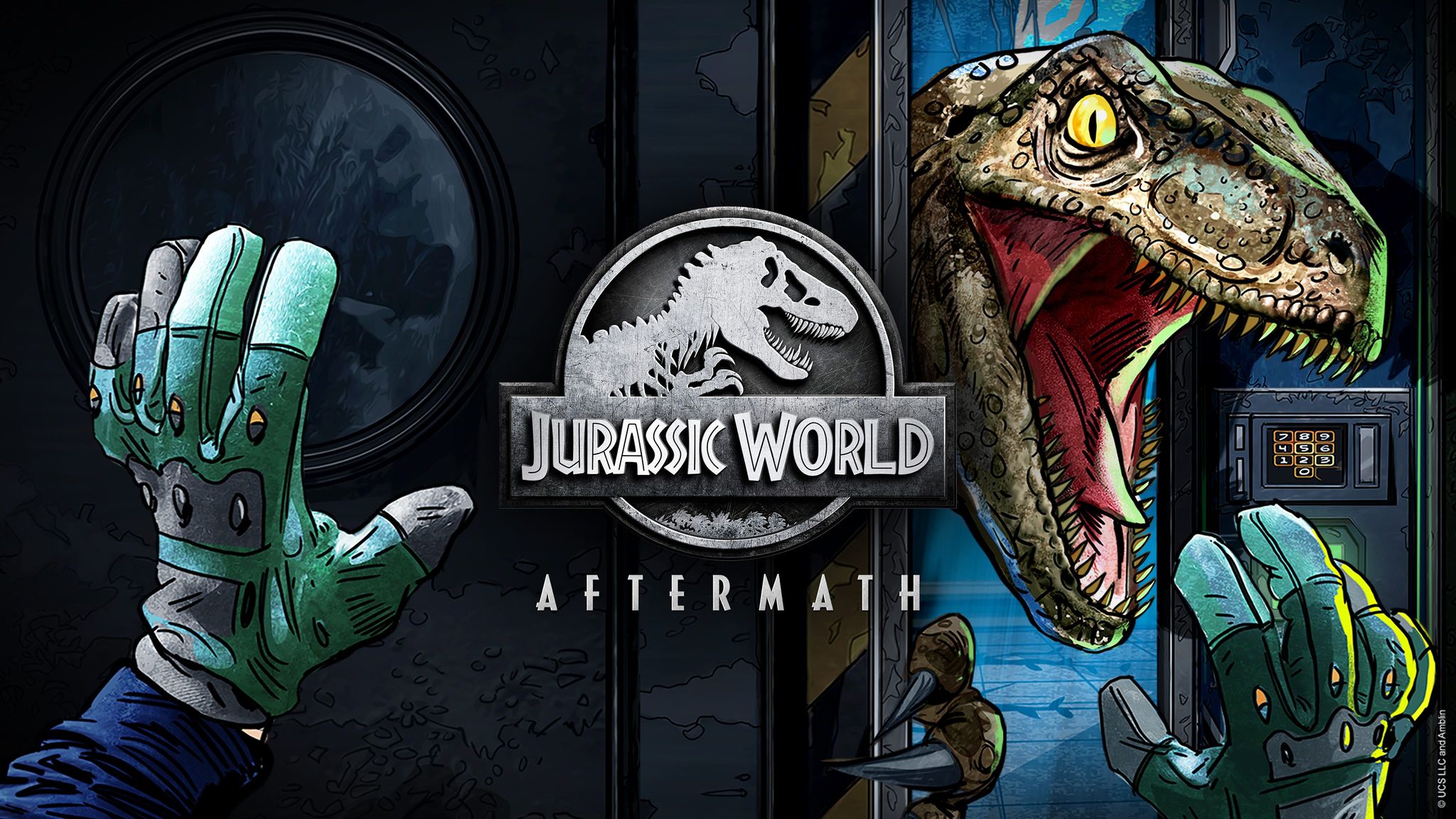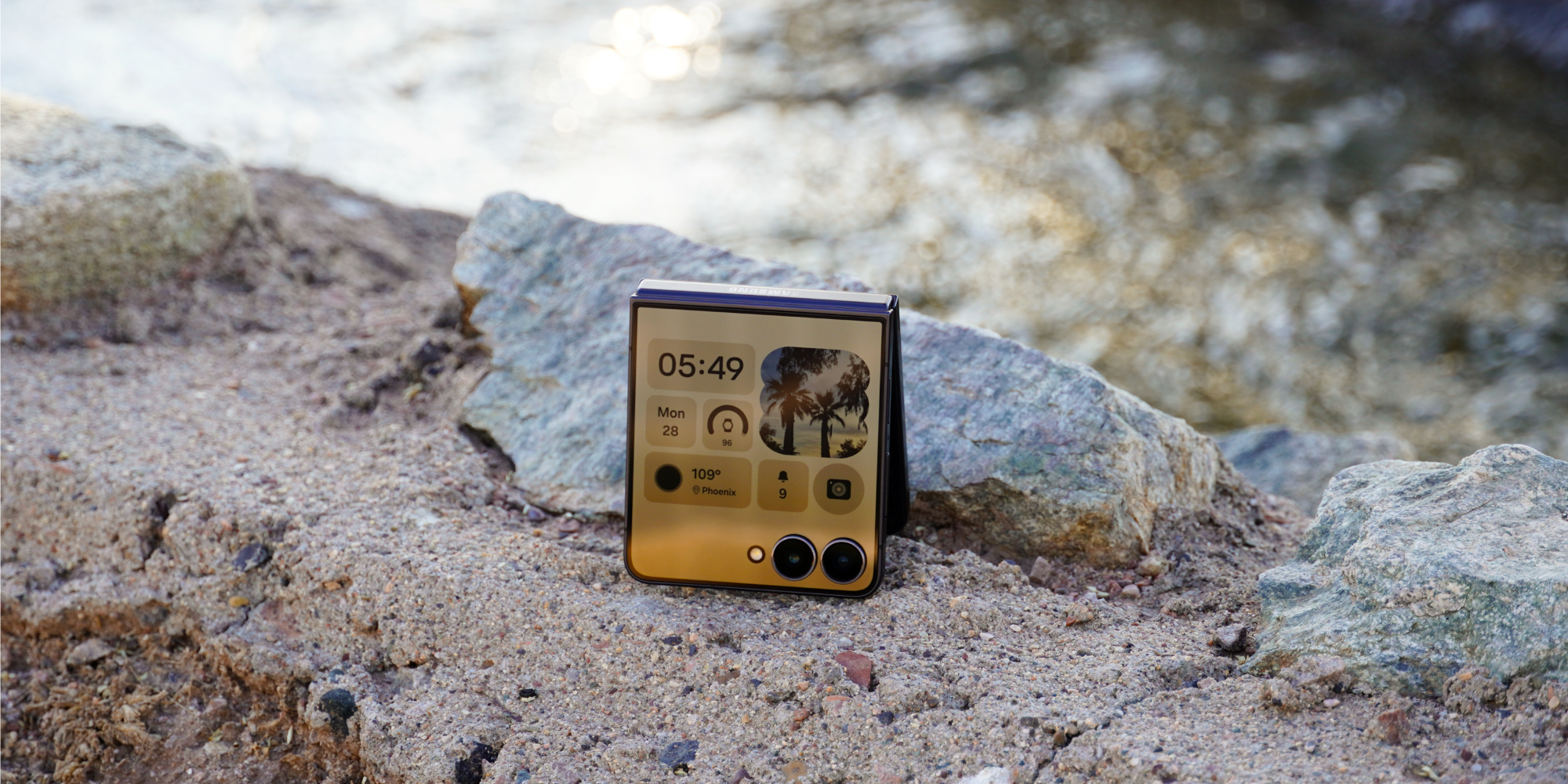Android Central Verdict
Bottom line: Jurassic World Aftermath is the stealth survival horror dino game I've always wanted in VR. It's simultaneously horrendously terrifying yet addictive and kept me hooked until the very end with its simple mechanics and to-the-point story.
Pros
- +
Stunning visuals and audio
- +
Rich, thick atmosphere
- +
Fear that feels organic, not scripted (no jump scares)
- +
Great VR design and accessibility options
Cons
- -
Raptors aren't exactly brilliant
- -
World interactivity is non-existent
- -
Half of the story (DLC coming later)
Why you can trust Android Central
Jurassic World Aftermath was only just announced at Facebook Connect in September, but the game seems to have released as quickly as a velociraptor can jump. As an exclusive for the Oculus Quest and Oculus Quest 2, developer Coatsink had many expectations to fill with a property as big as Jurassic World and a lot of fears to assuage when it came to developing a Quest-only VR title. Let me say this now: they've absolutely done what was needed to create the Jurassic game I've always wanted to play.
Forget the hokey Jurassic World movies for a moment and think back to the mid-90s when the original Jurassic Park came out. As an 8-year-old who was already deeply fascinated with dinosaurs, it was an incredible experience that will forever live in my memory. Powerful emotions elicit potent memories, and the sense of awe and wonder I felt was only eclipsed by the fear that quickly replaced it. Dinosaurs are absolutely terrifying, and I'll never forget what it was like to watch Lex and Tim narrowly escape the velociraptors in that kitchen scene.
While the Jurassic World movies are almost a parody of themselves, often replacing emotions with CG spectacle, Jurassic World Aftermath seems to have nailed a nearly perfect balance between the world of the new movies and the raw emotions of the classics. It doesn't focus on some massive-scale world or overarching world-building narratives; it just gets right to the point. You're dropped unceremoniously back on Isla Nublar to gather research data that was left behind, only to have your pilot eaten, co-adventurer holed up with a broken leg, and three velociraptors trying to kill you. Not scared yet? You will be.
It knows what it is
Jurassic World Aftermath: What I like
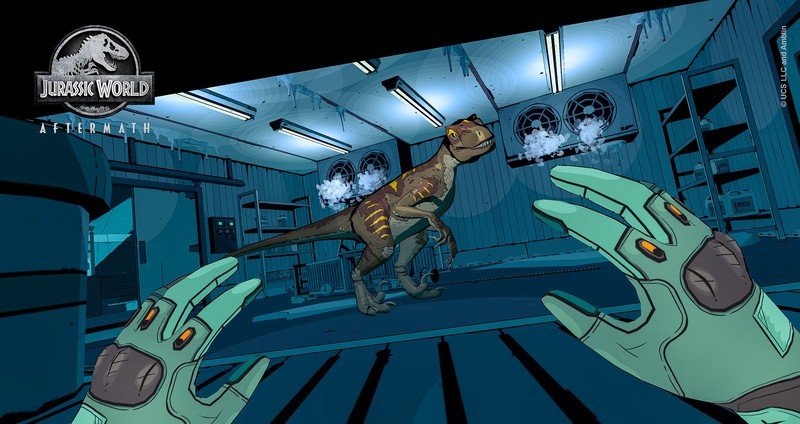
There's nothing like a good retcon when a story has been poorly executed. Case in point: basically the entirety of the Jurassic World movies, particularly the velociraptors that character Owen Grady trains in the movie (or as I like to call them, the "raptor bros"). To me, the thought of training something as ruthless as a velociraptor — a creature that the original movies taught us were intelligent and vicious — seemed completely preposterous. Thankfully, the Jurassic World Aftermath developers seem to have followed along the same line of thinking as me.
Instead of some hopelessly convoluted story in which the writers so obviously try to inject some form of overly-intellectual nonsense into, Jurassic World Aftermath keeps it simple. You fill the shoes of Sam, a security expert and professional smuggler who is hired by Dr. Mia Everett to retrieve some research data from the remains of Jurassic World in Isla Nublar. Taking place roughly two years after the events in the first Jurassic World movie, the park has been ravaged by time and dinos, including the surprise survival of several species who were supposed to have died off by then.


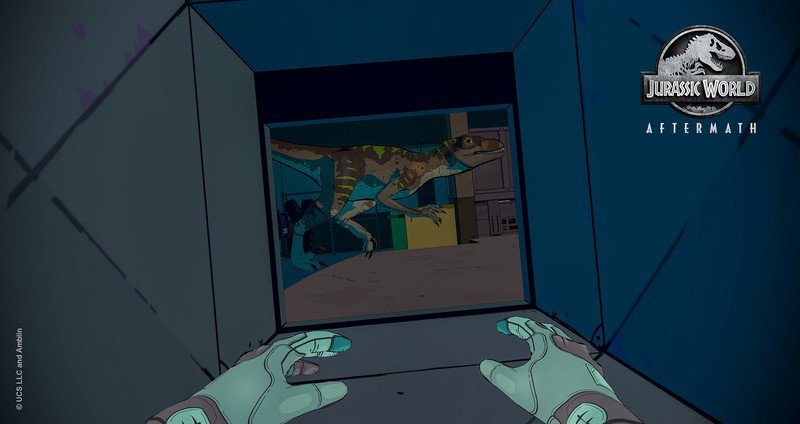
As is always the case in a Jurassic story, everything that could go wrong does go wrong, and you end up finding yourself having to trek back and forth across the sprawling facilities on Isla Nublar, relentlessly tracked down by a trio of velociraptors (and some other dinos, as well). It's not quite Metroidvania in its design, but you will be going back to a hub of sorts to unlock new areas to traverse to while sometimes backtracking to old areas once you've turned the power on or found out something new. Aftermath focuses its gameplay on stealth. There are no weapons and no real way to defend yourself — you'll simply have to hide and be patient. But that doesn't mean you don't have any tools at your disposal.
Get the latest news from Android Central, your trusted companion in the world of Android
There are no weapons and no real way to defend yourself — you'll simply have to hide and be patient
The gloves on your hands feature some simple gadgets, including a tool that allows you to remotely operate devices from several feet away. Since almost everything has been destroyed in Jurassic World, this typically means turning on static-filled speakers, starting up a broken printer, or flipping the switch on a radio to make some noise. In fact, everything in Jurassic World Aftermath makes noise — as should any good stealth game — so using this necessary factor of life to your advantage is a key factor to surviving.
Jurassic World Aftermath is visually and audibly excellent, sporting super-crisp visuals on a Quest 2 and AAA-quality narration, including Laura Bailey and Jeff Goldblum's voices — throughout the game. Despite the cartoony facade, the atmosphere is incredibly heavy and tense, transporting you into a believable world that's peppered with audio queues at just the right moments. Without even seeing the raptors stalking you, you'll hear them crawling through vents, be warned by a change in music pace of an incoming adversary, and be filled with a proper sense of dread when the screen turns red to let you know you've been singled out as a meal.
Despite the cartoony facade, the atmosphere is incredibly heavy, tense, and believable
For me, the simple-yet-refined stealth mechanics presented here were exactly what I was looking for in a Jurassic game. Like the story, the controls and world aren't complicated. There's not some grand physics playground to goof around in, no branching storyline to change, and really no other humans that you'll be speaking to. Just the narration of Dr. Everett and the audio files you'll find along the way while you uncover what the heck raptors are even doing in the facility in the first place and why you'd be sent back to some dangerous place like this despite the pay.
As you sneak from room to room in the game, you'll be presented with a series of puzzles to solve along the way that all make sense in the context of things. Unlocking doors is done by scanning your palm and following a sequence of actions. Interacting with computers and other terminals is done much in the same way, and you'll be aligning radar dishes and searching for radio frequencies by turning knobs and sliding levers. These puzzles add a level of stress to the game that's surprisingly helpful and well balanced. It's all very "VR" in its design, and that's just fine because, as I said before, everything in this game makes noise.
Click a knob, and a small comic-book-style set of lines will emit from it to let you know you're making noise. Open or shut a door too hard, and the same thing will follow. Run, and you'll be heard. Thankfully, the safest spots are regularly found throughout the world — lockers, air vents, and other hiding places that you can run and slide into, slam a door behind you and watch in suspense as the raptor is unable to get to you. This is real psychological horror; it doesn't rely on jump-scares or any tomfoolery like that. You're simply afraid because if the dino sees you, you're almost certainly dead, and it's most certainly your fault every time.
This is real psychological horror; it doesn't rely on jump-scares or any tomfoolery like that
Players who experience motion sickness or are unable to stand in VR will find lots of respites here. Coatsink did an amazing job of tailoring the experience to lots of different types of players, including folks who might not be able (or willing) to stand and crouch the entire time. Let me tell you; my body was sore the day after putting a marathon session in with the game, as it has you ducking and crouching a whole lot when you opt for the full physical experience.
Look, don't touch
Jurassic World Aftermath: What I don't like

Let's get this out of the way first: Jurassic World Aftermath is only half of the story. For $25, you'll be getting a game that will last you roughly 4 hours and deliver an extremely compelling experience, but the story leaves off on a cliffhanger and asks that we wait until sometime in 2021 to finish it. To be fair, a season of The Mandalorian is only slightly longer and has more than a year between releases, while the second part of Jurassic World Aftermath is expected sooner than a year from now. I'd personally recommend finishing this half now and waiting for the second, but you can hold off and binge the whole thing if that's more your style.
The other portion of the game that's "missing" is interaction. That may sound a bit odd, but you'll know what I'm talking about the second you start playing. Just about everything in the world around you is simply a facade to make it look disheveled and destroyed. You can't sift through debris around you, can't climb on things, and won't even be able to pick up simple items sitting on desks or the floor. They're there for decoration and that, to me, was probably the single biggest missed opportunity in the game.
Almost nothing in the game world can be interacted with, and that's a huge missed opportunity
Since Jurassic World Aftermath is a stealth game, relying on a convenient gadget on your wrist seems just a tad hokey. Being able to pick up a stapler from a desk and chuck it across the room to distract a dino would have felt far more organic. As it stands, you're simply at the mercy of the level designers and how they saw fit to tailor the experience rather than let you find your own way through the mire.
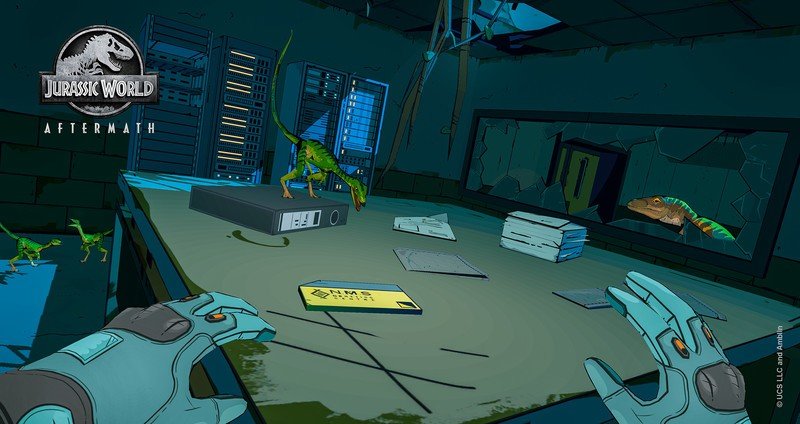
It's likely some of this design is based around the technical limitations of being on the original Quest. However, it may have had to do more with a short development window (or something similar) instead. Either way, you'll notice this odd omission and have to change your perspective to something much more video-gamey than organic in the way VR titles typically feel.
I'm glad that raptors in the game can't open doors; that really would have been too much for my heart to take.
There's also the distinct lack of intelligent AI present on what would normally be considered an intelligent animal in the Jurassic lore — the velociraptor. It's clear that, while they are tracking you on your journey throughout the station, the raptors are made mostly to patrol an area instead of realistically hunting you down. This mechanic is fine, truthfully, but it's worth noting that you'll treat the dinos more like guards from Metal Gear Solid than some intelligent creature that wants to make you its next meal. I'm honestly glad that they can't open doors, though; that really would have been too much for my heart to take.
The competition
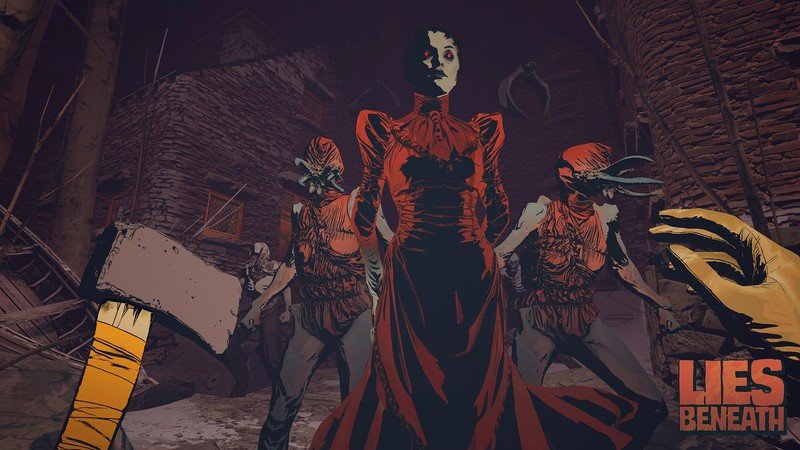
It's hard to pin down exactly what Jurassic World Aftermath's competition is. If you're looking for survival horror, there are few titles that'll get inside your skull as effectively as Lies Beneath on Oculus Quest. Junji Ito's unique brand of psychological horror will slap your brain with disturbing imagery over and over again as you try to escape from the remains of a car crash, only to find yourself in a haunted wood filled with unimaginable terror. It's a lot more horror than Jurassic, that's for sure.
If you're just in the mood for some stealth action titles, Phantom: Covert Ops and Espire 1: VR Operative will certainly fill the void. Both titles focus on a stealth-first experience, but each does it in a wholly unique way. Phantom will have you kayaking through the backwaters of a military operation. At the same time, Espire 1 puts you in the shoes of a remotely-operated robot operative whose goal is to infiltrate enemy compounds. Whichever way you prefer to move about, both are certainly great examples of how to make a stealth game in VR.
Jurassic World Aftermath: Should you buy
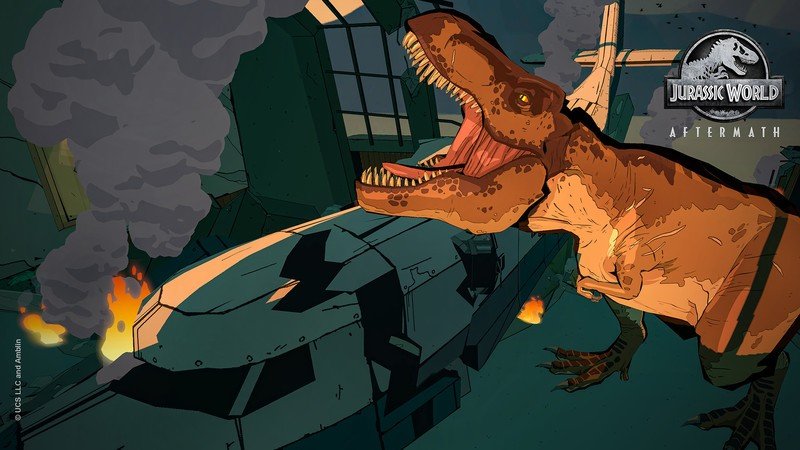
You should buy this if ...
You enjoy stealth games
Stealth is the heart and soul of Jurassic World Aftermath. There are no weapons, no defenses, just you and your wits trying to avoid a pack of velociraptors while you attempt to escape Isla Nublar with your life.
You love horror games
Since you've got no weapons in the game, there's a palpable sense of fear that comes with avoiding a hungry carnivore looking for its next meal. There's no cheesy jump scares or pitch-black rooms to fake scare you, only your natural sense of fear of being eaten alive by a vicious dinosaur.
You love Jurassic stuff
I'd say, "you love dinosaurs," but there really are only a handful in the game. Instead, if you live and breathe the world of Jurassic Park or Jurassic World, you'll feel right at home in this disheveled paradise.
You should not buy this if ...
You scare easily
Jurassic World Aftermath might be a stealth game, but it's also a survival horror. I had a hard time playing for the first hour, and if you don't do well with games that heighten your adrenaline and sense of fear, this certainly isn't a game you should be playing.
You want to shoot all the things
No guns here, only brains. If shooting is your thing, look elsewhere. Jurassic World is all about saving the dinos, not killing them (even if they want to kill you).
You want a deep narrative adventure
First off, why are you looking at anything from the Jurassic property if this your goal? Jurassic World Aftermath understands that story is not the forte of the Jurassic universe; it's all about emotions and presence. The world might not be giant or particularly interactive, and if that bothers you, look elsewhere.
Dinosaur fans will be thrilled to have a first-hand encounter with the trio of velociraptors (and other dinos) that they'll encounter in the game. There's nothing quite so unique as being hunted by something that's supposed to be extinct, and that's an experience that you can only truly get in VR. Being on the Quest is just such a perfect medium because there are no wires to get in the way when you have to dive into an air vent to escape death.
3.5 out of 5
While the atmosphere in the game is incredibly rich and believable, the fact that you can't pick up the debris and objects scattered about the world takes a bit of a toll on the immersion. The game generally shies away from feeling super "video-gamey," for the most part, but it's things like this that could be changed to improve the overall experience. It's also tough getting only half of the story right now, knowing that you'll likely need to buy the upcoming DLC just to finish it. At least the game is a good 4 hours long and doesn't feel ridiculously short, though.
Despite those issues, though, Jurassic World Aftermath remains an incredible experience that any stealth or survival horror fan would absolutely love. It's a wholly unique experience that truly has no rival on the market, and that's part of the charm of the title. If you've always wondered what it would feel like sneaking around a disheveled Jurassic park and being hunted by dinos, this is the title of your dreams.

